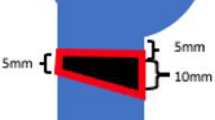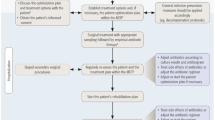Abstract
Background
Soft tissues (wound dehiscence, skin necrosis) and septic (wound infection, osteomyelitis) complications have been historically recognized as the most frequent complications in surgical treatment of high-energy proximal tibia fractures (PTFs). Staged management with a temporary external fixator is a commonly accepted strategy to prevent these complications. Nonetheless, there is a lack of evidence about when and how definitive external or internal definitive fixation should be chosen, and which variables are more relevant in determining soft tissues and septic complications risk. The aim of the present study is to retrospectively evaluate at midterm follow-up the results of a staged management protocol applied in a single trauma center for selective PTFs.
Methods
The study population included 24 cases of high-energy PTFs treated with spanning external fixation followed by delayed internal fixation. Severity of soft tissues damage and fracture type, timing of definitive treatment, clinical (ROM, knee stability, WOMAC and IOWA scores) and radiographic results as well as complications were recorded.
Results and conclusion
Complex fracture patterns were prevalent (AO C3 58.3%, Schatzker V–VI 79.1%), with severe soft tissues damage in 50% of cases. Mean time to definitive internal fixation was 6 days, with double-plate fixation mostly chosen. Clinical results were highly satisfying, with mean WOMAC and IOWA scores as 21.3 and 82.5, respectively. Soft tissue complication incidence was very low, with a single case of wound superficial infection (4.3%) and no cases (0%) of deep infection, skin necrosis or osteomyelitis. Staged management of high-energy PTFs leads to satisfying clinical and radiographic results with few complications in selected patients.





Similar content being viewed by others
References
Young MJ, Barrack RL (1994) Complications of internal fixation of tibial plateau fractures. Orthop Rev 23(2):149–154
Papagelopoulos PJ, Partsinevelos AA, Themistocleous GS, Mavrogenis AF, Korres DS, Soucacos PN (2006) Complications after tibia plateau fracture surgery. Injury 37:475–484
Thabet AM, Simson JE, Gerzina C, Dabash S, Adler A, Abdelgawad AA (2018) The impact of acute compartment syndrome on the outcome of tibia plateau fracture. Eur J Orthop Surg Traumatol 28(1):85–93
Canadian Orthopaedic Trauma Society (2006) Open reduction and internal fixation compared with circular fixator application for bicondylar tibial plateau fractures. J Bone Jt Surg 88:12
Drischl DR, Del Gaizo D (2007) Staged management of tibial plateau fractures. Am J Orthop (Belle Mead NJ) 36(4 Suppl):12–17
Sirkin M, Sanders R, Di Pasquale T, Herscovici D Jr (1999) A staged protocol for soft tissue management in the treatment of complex pilon fractures. J Orthop Trauma 13:78–84
Lavini F, Dall’Oca C, Mezzari S, Maluta T, Luminari E, Perusi F, Vecchini E, Magnan B (2014) Temporary bridging external fixation in distal tibial fracture. Int J Care Injured 45S:S58–S63
Egol KA, Tejwani NC, Capla EL, Wolinsky PL, Koval KJ (2005) Staged management of high-energy proximal tibia fractures (OTA types 41). The results of a prospective, standardized protocol. J Orthop Trauma 19:448–456
Krupp RJ, Malkani AL, Roberts CS, Seligson D, Crawford CH 3rd, Smith L (2009) Treatment of bicondylar tibia plateau fractures using locked plating versus external fixation. Orthopaedics 32:8
Schatzker J (1987) Fractures of the tibial plateau. In: Schatzker J, Tile M (eds) The rationale of operative fracture care. Springer, Berlin, pp 279–329
Muller M (1995) The comprehensive classification of long bones. In: Muller ME, Allgower M, Schneider R, Willenegger H (eds) Manual of internal fixation. Springer, Berlin, pp 118–158
Tscherne H, Ouster HJ (1982) A new classification of soft-tissue damage in open and closed fractures. Unfallheilkunde 85(3):111–115
Gustilo RB, Mendoza RM, Williams DN (1984) Problems in the management of type III (severe) open fractures: a new classification of type III open fractures. J Trauma 24:742–746
Whitehouse SL, Crawford RW, Learmonth ID (2008) Validation for the reduced Western Ontario and McMaster Universities Osteoarthritis Index function scale. J Orthop Surg 16–1:50–53
Merchant TC, Dietz FR (1989) Long-term follow-up after fractures of the tibial and fibular shafts. J Bone Joint Surg Am 71:599–606
Lundy DW, Albert MJ (2007) Pearls and pitfalls in the treatment of tibial plateau fractures. AAOS Now 9:24–31
Moore TM, Patzakis MJ, Harvey JP (1987) Tibial plateau fractures: definition, demographics, treatment rationale, and long-term results of closed traction management or operative reduction. J Orthop Trauma 1:97–119
Mahadeva D, Costa ML, Gaffey A (2008) Open reduction and internal fixation versus hybrid fixation for bicondylar/severe tibial plateau fractures: a systematic review of the literature. Arch Orthop Trauma Surg 128:1169–1175
Morris BJ, Zackary Unger R, Archer KR, Mathis SL, Perdue AM, Obremskey WT (2013) Risk Factors of infection after ORIF of bicondylar tibial plateau fractures. J Orthop Trauma 27:e196–e200
Musahl V, Tarkin I, Kobbe P, Tzioupis C, Siska PA, Pape HC (2009) New trends and techniques in open reduction and internal fixation of fractures of the tibial plateau. J Bone Jt Surg 91:426–433
Zura RD, Browne JA, Black MD, Olson SA (2007) Current management of high-energy tibial fractures. Curr Orthop 21:229–235
Laible C, Earl-Royal E, Davidovithch R, Walsh M, Egol KA (2012) Infection after spanning external fixation for high-energy tibial plateau fractures: is pin site-plate overlap a problem? J Orthop Trauma 26:92–97
Harwood PJ, Giannoudis PV, Probst C, Krettek C, Pape HC (2006) The risk of local infective complications after damage control procedures for femoral shaft fracture. J Orthop Trauma 20:181–189
Hodel S, Link BC, Babst R, Mallee WH, Posso P, Beeres FJP (2018) Perioperative management of external fixation in staged protocols: an international survey. Eur J Orthop Surg Traumatol 28(4):565–572
Gosling T, Schandelmaier P, Muller M, Hankemeier S, Wagner M, Krettek C (2005) Single lateral locked screw plating of bicondylar tibial plateau fractures. Clin Orthop 439:207–214
Weaver MJ, Harris MB, Strom AC, Smith M, Lhowe D, Zuralowski D, Vrahas MS (2012) Fracture pattern and fixation type related to loss of reduction in bicondylar tibial plateau fractures. Injury. Int J Care Injured 43:864–869
Shao J, Chang H, Zhu Y, Chen W, Zheng Z, Zhang H, Zhang Y (2017) Incidence and risk factors for surgical site infection after open reduction and internal fixation of tibial plateau fracture: a systematic review and meta-analysis. Int J Surg 41:176–182. https://doi.org/10.1016/j.ijsu.2017.03.085
Unno F, Lefaivre KA, Osterho G, Guy P, Broekhuyse HM, Blachut PA, Brien PJ (2017) Is early definitive fixation of bicondylar tibial plateau fractures safe? An observational cohort study. J Orthop Trauma 31(3):151–157
Colman M, Wright A, Gruen G, Siska P, Pape HC, Tarkin I (2013) Prolonged operative time increases infection rate in tibial plateau fractures. Int J Care Injured 44:249–252
Willis-Owen CA, Konyves A, Martin DK (2010) Factors affecting the incidence of infection in hip and knee replacement: an analysis of 5277 cases. J Bone Jt Surg Br 92(8):1128–1133
Funding
There is no funding source.
Author information
Authors and Affiliations
Corresponding author
Ethics declarations
Conflict of interest
Authors Gianluca Canton, Luigi Murena, Antonio Moretti, Emmanuele Santolini, Marco Stella, Michele Francesco Surace declare that they have no conflict of interest.
Ethical approval
This article does not contain any studies with human participants or animals performed by any of the authors.
Additional information
Publisher's Note
Springer Nature remains neutral with regard to jurisdictional claims in published maps and institutional affiliations.
Rights and permissions
About this article
Cite this article
Canton, G., Santolini, F., Stella, M. et al. Strategies to minimize soft tissues and septic complications in staged management of high-energy proximal tibia fractures. Eur J Orthop Surg Traumatol 30, 671–680 (2020). https://doi.org/10.1007/s00590-019-02619-9
Received:
Accepted:
Published:
Issue Date:
DOI: https://doi.org/10.1007/s00590-019-02619-9




